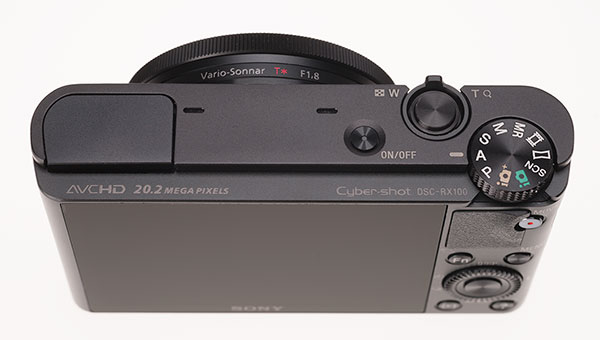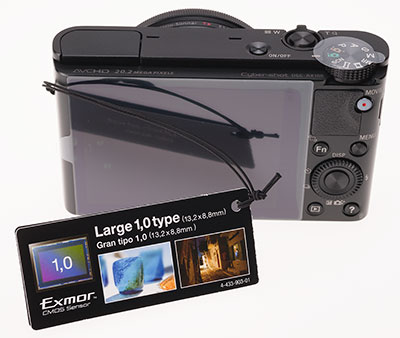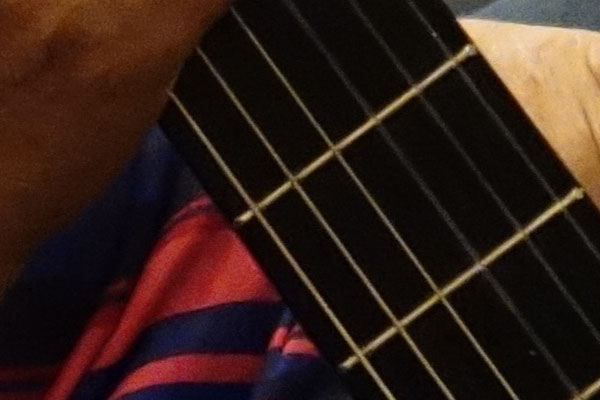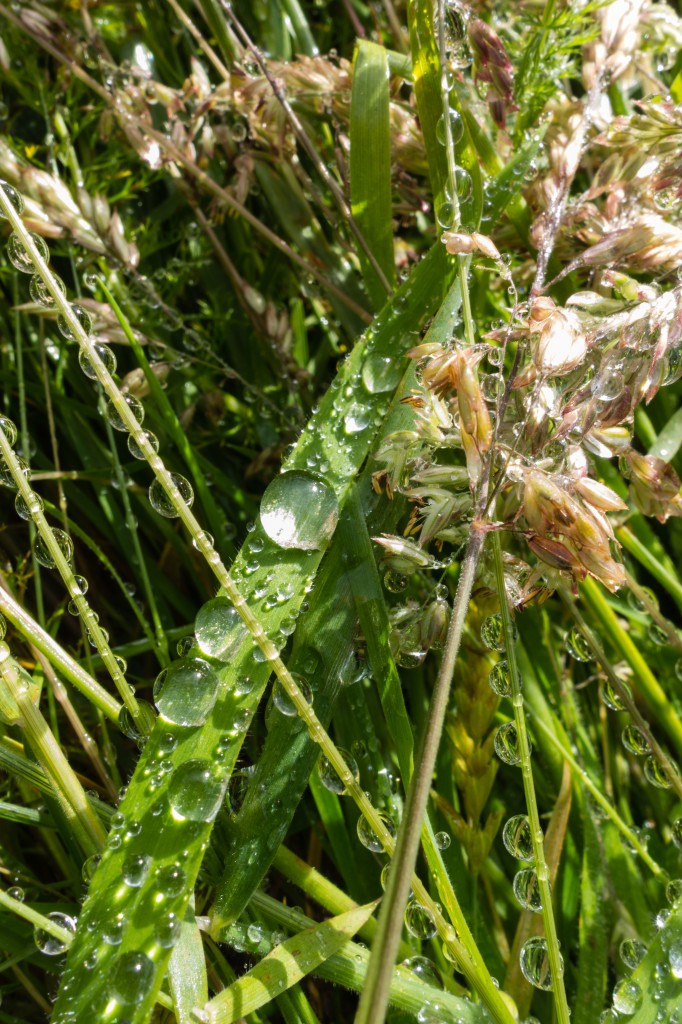Sony Cyber-shot DSC-RX100 review
The first thing that is likely to strike you about Sony’s one-inch sensor Cyber-shot DSC-RX100 is size. It’s tiny, slightly smaller in body than the Nikon 1 series interchangeable lens mirrorless cameras using an identical size 2.7X factor, one-inch or 13.2 x 8.8mm sensor.
This just a fraction over half the area of a standard APS-C sensor, and where Nikon has chosen to have 10 megapixels of active imaging plus others unused or devoted to phase-detect focus on the silicon, Sony has opted for 20 megapixels.
At first this seems excessive, until the performance of other new smaller sensor cameras is considered. The Fuji X-10, for example, has a 12 megapixel sensor measuring 8.8 x 6.6mm and achieves a respectable balance of sharpness and noise-levels. The RX100 has a slightly lower pixel density. Compared to the Canon G12 it’s four times the sensor size and twice the sensel size.
The 1.0 type sensor also gives just that little bit more creative control over depth of field. With the usual third to two-thirds inch standard sensors in pocketable compacts, the lens must be used wide open at any given focal length to provide a degree of differential focus. To avoid sharpness loss, most such cameras can not be stopped down to settings like f/11 and sometimes have a choice between two apertures only, wide open and something moderate like f/8.
The Fuji X10 zoom only stops down to f/11 but offers a full continuous range of settings. So does the RX100, its 10.4-37.1mm lens ranging from f/1.8 to f/4.9 wide open but limited to f/11 minimum regardless of zoom setting. Since even f/11 can produce some diffraction-limit related softening, its performance around f/5.6 is critical. This would be the setting I would choose for routine Aperture-priority shooting.
At such a setting, the low ISO quality of the RX100 can be exploited. Unlike any of the Sony NEX models, the little RX100 has been given user control of maximum and minimum Auto ISO limits. The full auto range is from 125 to 6400. Manually set ISO can be extended downwards to either 80 or 100 (but these settings just overexpose the image and compensate in conversion). The camera seems to have been developed as well as manufactured in Japan, and the firmware and menu system resembles the mainstream Alpha DSLR/SLT camera line rather than the mirrorless NEX. Editor’s note: having sold my original RX100 I bought another, the second although made at the same date, is made in China. It seems either better or no worse.
The shutter is speeded to 1/2000th which is not a very fast high speed for a camera capable of 10 frames a second action bursts (or 2.5fps normal continuous shooting). The longest exposure possible is 30 seconds. By whatever means, aperture or shutter, Sony allow control to within 1/3rd EV step and compensation to ±3EV, but AE Bracketing is limited to three frames at either ±0.3 or ±0.6EV.
Control over settings is handled by a single top mode dial, a shutter release with power zoom lever to the front, a rear Control Wheel with four cardinal point click functions, four further surrounding buttons, and a Control Ring set round the lens bezel. This can be silent or make click sounds to mark setting changes but lacks physical resistance or detents. It doubles as a fine focus ring when the camera is set to manual focus, aided by focus peaking and on-screen magnification. Its action is very smooth indeed, and it can be operated easily by a single finger from either hand.
Real photo – the film and lens are entirely hidden behind the RX100 but imaged by its close focus ability at 10.4mm
Considering the 101 x 58mm footprint of the body, everything is designed efficiently to allow a 3 inch rear screen using 1.2k dots and an additional white-light augmenting RGB to improve sunny day use. It’s not a touch screen, nor is it articulated or hinged. But you will touch it, for sure… a cloth to wipe off your thumbprints is an essential accessory. It appears to be glass, but may just be a hard coated plastic layer, something with which Sony has a bad history.
Actual size next to a CF card, which this camera of course does not use – it takes SD or Memory Stick Pro Duo.
The new small battery type NP-BX1 allows 330 shots – better than many high pixel count consumer DSLRs and mirrorless models now – and can only be charged in the camera itself, via any USB 5v source and the supplied Micro USB connector cable. This is not a standard Mini USB, just as the Micro HDMI (cable not supplied) is not a commonly found fitting.
Against the disadvantage of in-camera charging you can set in-car charging, laptop or phone supply charging, and the camera’s ability to run without a battery installed when connected to its supplied AC charger. Both third party lith-ion cells and third party external chargers can be found on eBay. Anything which offers a standard, powered USB connection can charge the RX100.
The British charger is an old warhorse. The US charger is a neat monobloc transformer half this size with folding AC mains pins. This kludge is bigger and heavier than the camera…
A full charge takes 155 minutes using the charger with its high level USB-power output, but may take longer through a PC USB port or devices providing minimal USB power. You can leave it plugged in to USB all the time as the charge cycle is cut off when an orange charging light in the on/off switch extinguishes. When the camera is switched on to connect to the computer as Mass Storage (etc), this light turns green. It is possible to use the RX100 without the battery installed, connected to the charger.
In the box, you get no software, only an instruction manual which covers the bare bones. It seems to be assumed that what Sony call the best ‘professional’s compact’ ever will be bought by experienced digital camera users. Nearly all the functions on the RX100 from sweep panorama to HDR and noise reducing multishot modes are found on other cameras, and the location and nomenclature of all functions is at least familiar. Download links are given for a PDF identical to the bare manual, or a web-page based version with colour illustrations which is far better but can’t be downloaded.
Here is the link for the full colour, more detailed user manual: http://pdf.crse.com/manuals/4432943111/EN/index.html
A wrist strap is supplied, along with two neat cord and leatherette toggles to attach a regular camera neckstrap, as the body has two almost microscopic strap lugs. Nothing other than the very fine cords of Sony’s strap or strapholders would be likely to fit.
The body is solidly made and all access doors seal well, but it’s not resistant to anything wet, dusty or involving hard surfaces and heights. The lens’s rear glass is located very close to the sensor, and zooming appears to move only the middle and front groups. This should make it dust-free for life. Time will tell, and if any dust ever does get on the sensor, it will need a factory repair. But it looks to be designed so that will never happen.
For the professional user, the big appeal of this camera is its invisibility. Only 36mm thick with the lens collapsed, it’s just a fraction fatter and smaller than an iPhone, and with focusing down to under two inches there’s hardly anything it can’t capture. Users may criticise the 28-100mm equivalent focal length range, preferring 24mm if possible, but the focal length of the zoom is stated after allowing for some strong in-camera distortion corrections at the wide end.
To achieve a 28mm field of view (73°) for an in-camera JPEG, the corrections must deal with a very high level of barrel distortion. The raw file is uncorrected, and shows a diagonal field of view closer to that of a 24mm (85°). This may explain why Sony’s own information has claimed both 24mm and 28mm as the widest angle, when the stated focal length and sensor size clearly equate to 28mm. My measurements from the two image versions below indicate that if the correct equivalent is 28mm, the uncorrected diagonal angle is equivalent to a 24.8mm. Either way the RX100 should not be criticised if you could be happy with a new Canon EOS M – 1.6X sensor, 18-55mm lens, that’s a 28.8mm widest limit before applying Adobe Lens Profile corrections which will probably reduce the true angle to a 31mm.
And that of course applies to almost all wide angle lenses except the Sony NEX E 16mm f/2.8, which has pincushion not barrel distortion and therefore does not lose any of its diagonal angle (for that is how lens angles are measured) when corrected. There is an inbuilt profile for the latest ACR and Lightroom, but unlike other Adobe Lens Profiles, you can not adjust or turn off the disortion control. Apply the profile does not move any pixels, it simply corrects vignetting and CA. These programs are reading metadata in the raw file to apply the geometric correction automatically and you can’t disable it. To see the full field of view of the lens at its 10.4mm focal length, you must use a processor like Iridient Raw Developer (Mac only) which ignores the instructions.
Above: in-camera fully corrected JPEG at 10.4mm, and uncorrected raw conversion (by Iridient Raw Developer) showing full view angle of the lens before removing the high level of barrel distortion. Just move your cursor over the image to see the change. Adobe programs prevent the removal of the camera’s automatic correction – you can’t get to the ‘wide’ version.
When shooting video in 16:9 format with stabilisation set to Standard (optical) or Off, the lens range is trimmed to 29-105mm equivalent, and the image is cropped only slightly on pressing the Movie button. If you set Active stabilisation for video, optical stabilisation is replaced by pixel shift electronic stabilisation on the sensor. The crop is to 0.87X of the normal video field (measured here), meaning that the effective focal length range for Active video is 33-120mm. This 0.87X factor is exactly the same as the NEX-7 video crop factor.
The RX100 can be concealed in your hand and when used, with no eye-level viewfinder and composition on the rear screen instead, you look like any cameraphone user or tourist. In fact you are capturing what could be a highly detailed 20 megapixel image suitable for double page magazine or newspaper repro.
This is, of course, also a camera which won’t get you thrown out of sports stadiums or concert venues despite its ability to capture 50/60p HD1080 video with good quality stereo sound, and to capture full resolution JPEG still frames during video (17 or 24Mbps, not 28Mbps) without interruption. Writing the JPEG takes some time, parallel to video writing, and a faster SDHC or MS Pro Duo card is recommended. It can record AVCHD-2 format movies at up to 28 megabits per second, with AF during video and a good degree of setting control including manual exposure. It can not capture raw still files during filming. There is a faint click sound only during the video.
Output
As for the quality of results, the lens may be letting the sensor down slightly; although very high in resolution even wide open, corners can lose detail because the focus plane is far from flat. Bright lights or overexposed details can produce a visible flare or glow, it’s possible to get purple fringes. Against this you must set pixel-crisp sharpness wide open, at any focal length, in many shots.
The exposure over-ride is excellent, and the screen really gives an exact view of what you are doing. Here, minus 2 stops was needed. This is at ISO 125, 1/25th at f/5.0 at 17mm (45mm equivalent) focal length. The original file has perfect detail corner to corner – every leaf sharp.
At the best – ISO 80 to 125, stopped down just one full step from full aperture – the RX100 can match or better the typical output of a 21 megapixel full frame DSLR with 24-105mm lens. At the worst it’s better than any smaller sensor compact, especially if the 10 megapixel JPEG shooting option is chosen or the file size is reduced to match a typical 12-16 megapixel 2/3rds inch sensor image.
One of my first tests, wide open at f/4.9 at 37.1mm and auto set to ISO 500, in camera JPEG. Just lovely colour and tone, perfect WB, perfect auto exposure. An early fallen leaf.
High ISO results are encouraging – using ISO 800 or 1600 should be no barrier to large clean reproductions, 3200 and 6400 remain clean in good light with detailed subjects but show coarse mottled grain in defocused areas with low light. Multishot modes are similar to NEX and can greatly improve results, but for my tests I stuck to raw files (though all the examples shown here are from in-camera JPEG) and single shot modes. Also, with f/1.8 apparently as sharp as most lenses well stopped down and having plenty of depth of field, I have tended to use low ISO settings in conditions where I’d set my Alpha 77 to ISO 800.
This shot was taken at 1/100th at f/1.8 at ISO 125, just because with this camera you CAN – no need for high ISO when you have f/1.8 at 10.4mm. But how about lens quality, how about depth of field? Take a look – all clips from the in-camera JPEG:
You can see the tendency to flare around light sources, and remember – this is an optically corrected image. Look at this in raw, and the purple fringes on those lights are the most colourful thing in the shot. This is from the middle of the frame.
Here’s the extreme right hand up to the very edge. Remember, it’s a 28mm f/1.8 equivalent.
Here’s the left hand, further away, a little bit in from the edge to catch the best detailed target.
And here is the bit you expect to be awful, more distant trees against the sky. Not bad for f/1.8?
Active video stabilisation is pixel-shift electronic, still stabilisation and standard video are in-lens optical. Both work well and the electronic variety is particularly good at dealing with small movements of your hand when holding such a small device for filming. Video quality is a match for any HD1080 DSLR, with a true 50p or 60p (USA) frame rate. The RX100 also has full user control over ISO, shutter speed, aperture and manual focus during video; the shutter-release zoom lever provides a smooth slow fixed speed zoom during filming. Beyond the 3.6X optical range, further digital zooming drops sharpness and can not be recommended. The point where digital takes over is well defined by a pause in zoom travel but you can not disable digital zoom to 14X maximum.
ISO 3200, 1/30th at f/1.8, 10.4mm, very low yellow pub light.
100% clip of in-camera 3200 JPEG – maybe a bit rough, but not bad at all…
White balance is generally well optimised, exposure is less predictable in difficult conditions. The multi-zone metering and focusing settings can produce unexpected results, spot and single point choices may not do any better as they will favour just the targeted tone. Access to +/- compensation is rapid. It can be assigned to the ring round the lens. This control ring is smooth in action and works well for adjusting exposure while viewing the rear screen.
Faults or flaws
The uncorrected image has fairly strong CA, which in defocused zones (especially that critical phase between sharp and truly out of focus) can create purple fringes on a large scale. The camera software turns these into white glow. Slightly defocused detail, especially if brightly lit beyond the clipping range of the sensor, can produce unpleasant bright fringes which are impossible to remove. Very bright areas even when well focused tend to flare into their surroundings.
I don’t really want to show what the fully lit bits of lichen at minimum focus look like – the highlights flare a fair amount.
Dynamic range is good, but not exceptional. Highlights clip readily, and recovery in either Raw Developer or IDC v4 did not pull in missing detail, it just darkened the value of a sharply clipped high bit. Though ISO 80 and 100 provide finer grain, they are less use than ISO 125 or 200 in contrasty light or with flash, as they clip more. Highlight colour recovery and use of DRO can produce some very odd effects. Editor’s note: since this original review, ACR/LR has been updated to process the raw files, and this is one reason I’ve bought an RX100 for the second time. I can now tames some of the lens and dynamic range issues very effectively.
At minimum focus, the aberrations get worse and overall sharpness is reduced, especially around the wide angle and two or three inches working distance with the lens wide open. It is easy enough to get know the lens, and its substantial sweet spot (almost anything not close-up, not contrasty or with patches of extreme overexposure). Having said that, you can also obtain stunning close ups at 10.4mm:
Click on this, and you can download the full size (probably crunched a bit from Level 10 JPEG by WordPress) image file. You will see a world of detail to amaze you and some fascinating aberrations and artefacts as well – perfect in a way, imperfect no doubt, but a wonderful thing to be able to do with a camera so small you can get it down into the a subject like grass. f/11, 10.4mm, hand-held, 1/40th at ISO 125, ACR processing.
High ISO JPEGs look clean in good light with hard detail. They look very mottled and mushy in darker softly focus areas of smooth tone. You may want to avoid using 3200 or 6400, but remember – the lens is f/1.8 to f/4.9, covering a range which is typically represented by an f/3.5 to f/5.6. At the wider to middle end, there is a two-stop advantage fading to a third-stop at the tele setting. If you stick to the wide angle end, you can use ISO 800 with as much success as 3200 would achieve in a DSLR, and pretty well the same depth of field too.
Design – the most annoying single thing is the pop-up flash which sits exactly where you are likely to hold the camera body at the left hand end. You will just have to learn not to hold it that way! That’s a penalty paid for such a small body. The tripod bush is also off centre to the lens. This only matters for specialised multi shot assembly or macro stepping.
Does it work?
Yes! The RX100 is actually a great little companion camera, and after getting it, I stopped using my NEX-5n kit for casual everyday snaps. The RX100 lives in my wallet beltpack or a carefully emptied and cleaned-out pocket, wrapped in a microfibre cloth. I may shoot a few pix or a video clip, and every day, I just connect the camera to my iMac and use iMovie to Archive the entire media contents. This copies all movies and also all stills. I then format the card before the next use, and the camera is always fully charged when I pick it up off the desk.
My best pictures are every bit as a good as a typical NEX-5n with 18-55mm shot, my worst results are better than most consumer pocket cameras and no worse than the worst NEX shots. You can take bad pictures with any camera! My videos are as good as any of the NEX or Alpha models so far, and streets ahead of Canon, even including Canon DSLRs used by professionals. I would give the Nikon D800 videos the edge over RX100, and NEX-7 or Alpha 77 videos equal status. All are far more detailed and crisp than Canon’s HD1080, yet that is now a bit of an industry standard. I predict that the RX100 will gain a bit of a cult following for video making. Its movie setting on the mode dial allows user-set aperture and shutter speed, full control once you add manual focus.
Suggestions that it may supplant NEX are groundless. You can fit wonderful glass on NEX, and get 24 megapixels to the highest standard. You can’t fit wonderful glass on the RX100 and the zoom it comes with, Carl Zeiss or not, has clearly visible distortion and aberration issues that depend on firmware or software for correction.
Is it worth the money?
Maybe. I think the RX100 has been overpriced by around £100 in the UK but I see that many retailers are already dropping the price by that amount. Around £400-450 seems a fair price, the official £550-580 is high. Update: we sold our (Japan, June 2012) RX100 for £400 in August 2012. A replacement (China, July 2012) was found as new for £385, eBay used, in February 2013. New prices are now more of less where we suggested they should be, mid £400s UK, cheaper USA.
– David Kilpatrick
Check out the price of the RX100 from B&H

























